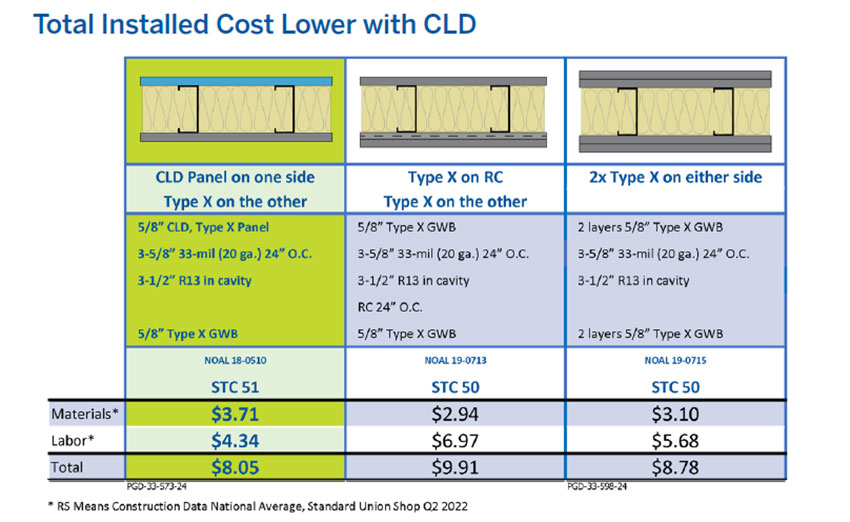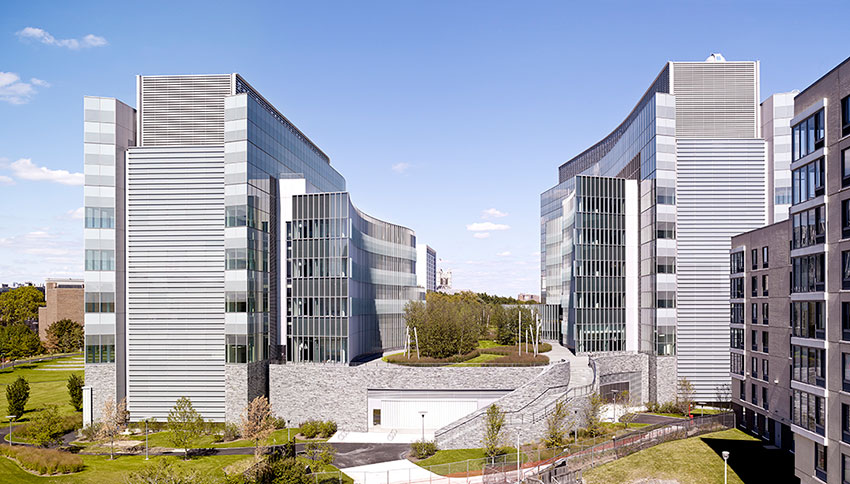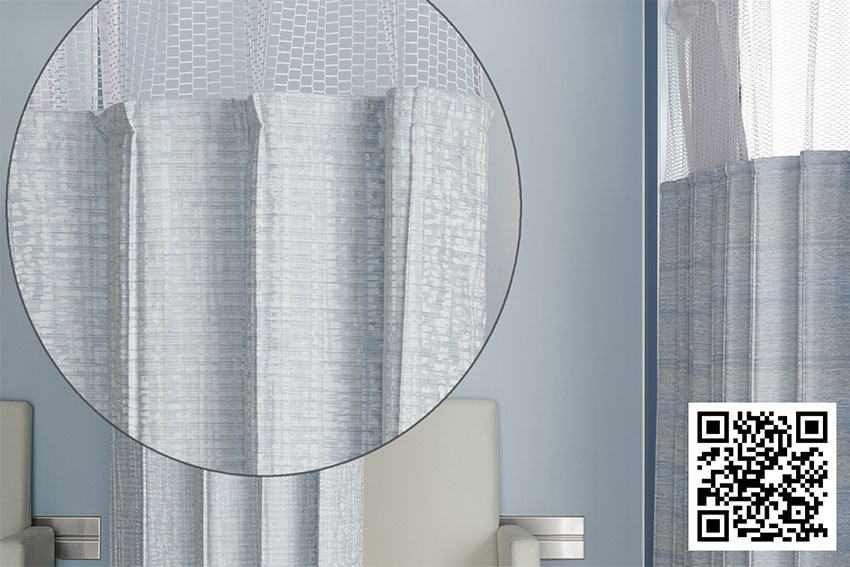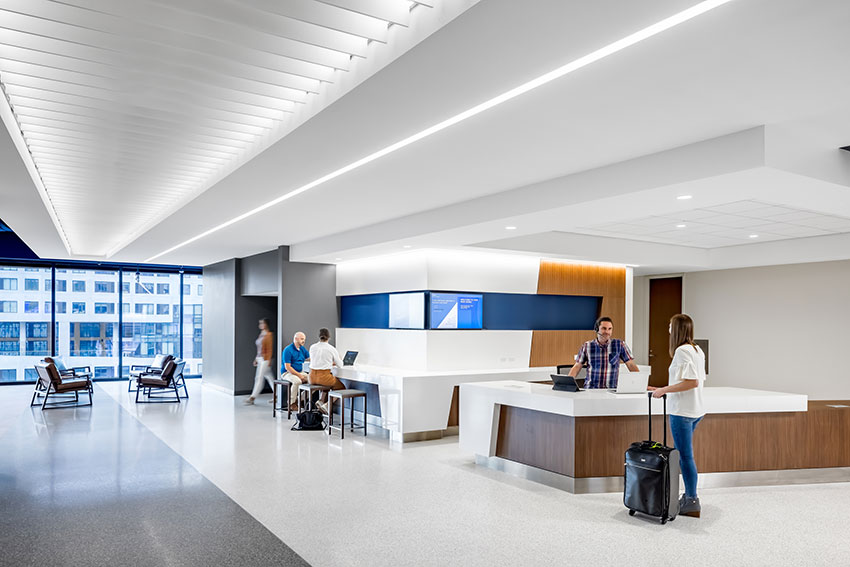Sound Experiences in Buildings
Types of CLD Panels
Just like other gypsum products, CLD panels can be manufactured to meet or exceed other building code requirements. CLD panels have been tested in a number of different types of assemblies to provide different fire-resistant-rated partitions that can be used to satisfy building code requirements.
Some project applications require mold-resistant drywall panels. CLD panels can be manufactured to meet these requirements as well using special formulations for both the core and paper facings. Typically, mold-resistant CLD panels are available in thicknesses of ½” for use in non-fire-resistance-rated partitions and 5/8” Type X for use in rated assemblies. For circumstances that warrant it, there is also sound reducing drywall that can resist impact and abuse.
Ease of Installation
Field installed products are often only as good as their ability to be installed properly. CLD panels offer some specific advantages when it comes to installation. First, there may be fewer layers of drywall to install – STC ratings can be achieved with a single CLD panel instead of multiple layers of drywall. That saves installation time, reduces action steps, and helps control labor costs. Second, at least one manufacturer has developed panels that allow installers the ability to easily score, snap, and install the drywall just like standard gypsum wall panels since there is no paper or metal in the center of the panel. Overall, the drywall delivers high acoustic performance with improved workability to speed up installation time.
Related Products
In order to achieve the best performance using CLD or any acoustic treatment, the penetrations and perimeter of the walls need to be addressed. Typically, this means acoustical sealants need to be applied to the perimeter of the wall and acoustical putty to the penetrations.
With the wide variety of building types and possible applications, it is recommended to work with a manufacturer and an acoustic consultant early in the design process to determine the best and most cost-effective products for any given project. It is also best to work with manufacturers that bring a depth of technical knowledge, independent testing results, and a willingness to share the data with the design professionals who request it. At least one company has conducted more than 1,000 ASTM E90 Sound Transmission Loss (STL) tests with varying framing and panel configurations. This level of testing and analysis on building noise control is rare but valuable to supporting the design professions and the building construction industry.
Cost-Effectiveness
A comparison of CLD panels contrasted with other typical interior partition assemblies reveals the nature of their cost effectiveness. As shown in the following chart, an assembly with a CLD panel on one side and a Type X gypsum panel on the other is installed over standard 33 mil metal studs with insulation between the studs. This assembly has been tested and shown to achieve a sound rating of STC-51. Pricing out this assembly using conventional pricing data (based on RS Means Construction Data – national average) shows a calculated material cost of $3.71 per foot, a labor cost of $4.34, and a total of $8.05 per square foot.
By comparison, a similar assembly is shown in the chart which uses a single layer of Type X drywall on each side of insulated metal studs but with one side receiving a resilient channel. This assembly has been documented to produce a slightly lower STC-50. The cost for this assembly is a bit less for materials at $2.94 but notably more for labor at $6.97 totaling $9.91 per square foot or about 23 percent more than the CLD assembly.
Similarly, using 2 layers of Type X drywall on either side of the same insulated metal studs also produces a documented slightly lower STC-50 rating. The cost for this assembly includes materials at a mid-point of $3.10 but notable labor cost of $5.68 totaling $8.78 which is still over 9 percent more than the CLD assembly. Multiplying this level of savings across an entire building quickly adds up to noticeable cost savings, all while achieving a superior acoustical performance.
Deanna Crossman is the owner of The Mayton Inn, a luxury boutique hotel in Cary, North Carolina. She reflects on a recent project there: “We were targeting an STC of 62-65 in the guest rooms and the performance exceeded our expectations. We found CLD sound-reducing gypsum panels to be a cost-effective part of our strategy. It was the perfect balance between material cost vs. the labor savings in installation."

Image courtesy of PABCO® Gypsum

Photo courtesy of Construction Specialties, Inc.
Acoustical architectural louvers can be designed to fit into a building and provide noise reduction where it is needed.
Acoustical Architectural Louvers
Louvers are used on commercial buildings to ventilate a space for HVAC equipment, either for exhaust ventilation or for air intake ventilation. The walls and space where those louvers are located may also have some acoustical requirements to keep outside noise out or inside noise in. This could be an application where normal HVAC mechanical equipment is functioning or one in which a backup generator is in close proximity to an occupied space. In those cases, acoustical architectural louvers are the best choice to minimize sound without losing ventilation. Acoustical louvers provide protection from water penetration and good airflow performance.
Acoustical architectural louvers are typically used whenever sound attenuation or minimizing noise is essential to the project. They may also be specified whenever it is necessary to reduce sound levels from noise that escapes from exterior or interior walls. Depending on the relative priority of the noise reduction compared to the airflow needed, manufacturers offer different makes and models of acoustical architectural louvers to suit different performance needs including varying depths and air and water performance.
Acoustical architectural louvers are typically solid louvers that are filled with fiberglass insulation that provides a noise reduction (NR) between 14 and 23 depending on the frequency of the sound. In this way, they can reduce the level of sound entering or leaving the building or passing to spaces within a structure.
Some other considerations of selecting acoustical architectural louvers include the following.
Notice

www.c-sgroup.com

www.PABCOgypsum.com/tsdg

www.rockfon.com









